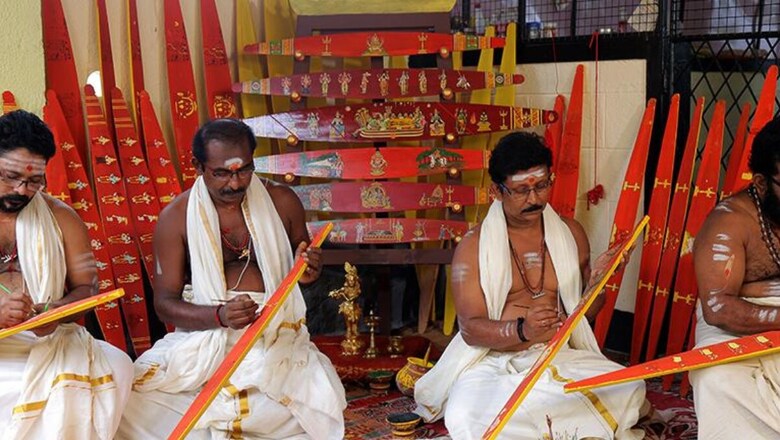
views
On behalf of the devotees of Lord Padmanabha, the renowned Sree Padmanabhaswamy Temple in Thiruvananthapuram has presented ‘Onavillu’, a traditional ceremonial bow, to the Ram Temple in UP’s Ayodhya to mark the occasion of Pran Pratishtha (consecration) on January 22. The bow was presented as a gift to the Ram Temple and will be taken to Ayodhya on a flight from Kochi, on January 21, authorities said.
Temple Tantri (Chief Priest) and its administrative panel members handed over the ‘Onavillu’ to the Shri Ram Teerth Kshetra Trust representatives at a function at the eastern entrance of the shrine on January 18.
What is Onavillu?
‘Onavillu’ or ‘Palli Villu’ (divine bow) is an auspicious offering dedicated to Lord Sree Padmanabha on the occasion of Thiruvonam. It is a broad, flat, elongated wooden piece with miniature paintings of gods. It was called ‘Palli Villu’ in ancient times and was later termed ‘Onavillu’ as it was offered to the temple during the Onam days. According to records of the temple, “the ‘Palli Villu’ offering was resumed in AD 1502, after the temple renovation”, which sheds light on the immemorial tradition.

The Onavillu is considered to bring fortune, serenity and bliss to its worshippers. Once dedicated to the temple, Onavillus are also purchased by devotees to be worshipped at home.
Story of the Divine Bow
The legend of Onam is the return of King Mahabali, who once ruled the state of Kerala, to visit his subjects from the nether world. According to mythology, King Mahabali requested Lord Vishnu to display to him all his divine incarnations, when Vamana, the dwarf incarnation of Lord Vishnu, was about to push him to the nether world. Lord Vishnu approved but could only be seen as paintings and instructed Vishvakarma, the celestial architect, to paint. Vishvakarma assured that his successors would persist in making these ‘villus’ and offer them to Lord Padmanabhaswamy to be viewed by Mahabali on his annual visits.
Following are the six types of Onavillus:
- Ananthasayanam or Sree Padmanabhaswamy (Lord Vishnu) on his serpent bed
- Dashavatharam or the ten incarnations of Lord Vishnu
- Sree Krishna Leela or his dance with the gopikas
- Sree Rama Pattabhishekam or the coronation of Lord Ram
- Sree Dharmasastha for Lord Sastha
- Vinayaka for Lord Ganesha
Each of the six is of different sizes and shapes. The smallest ones are Sree Krishna Leela and Vinayaka — 3.5-feet-long and four inches wide, while the longest are Ananthasayanam and Dasavatharam that are 4.5 feet long and six inches wide.
A notable aspect of this ritual is that the bows are made by one family only which is authorised with this duty. Known as the Karamana Melarannoor Vilayil Veedu, they reside at Karamana in Thiruvananthapuram.
The bows are made out of wood from kadambu or mahogany, considered to be the favourite of Lord Vishnu. The family that makes these observes several rituals and constraints, including a 41-day penance before commencing the work. Natural ingredients like charcoal and turmeric powder are used for colours. The bows showcase the Dravidian painting style and are made using only five colours or the panchavarna — white, green, red, yellow, and black.




















Comments
0 comment